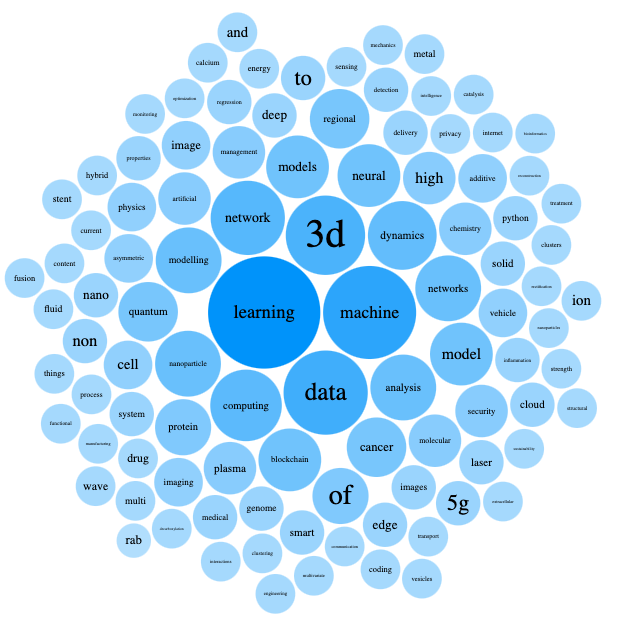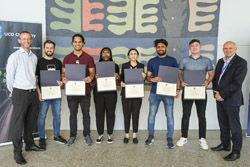
Symposium Registration Information
- The Symposium registration is only open to UCD research graduate students (i.e., either PhD or Master by Research) and postdoctoral fellows currently registered in either the UCD College of Science or the UCD College of Engineering & Architecture.
- The Symposium will consist of up to 300 poster presentations. All posters must be registered and presented by at least one (co)author who is currently registered as a graduate research student or postdoctoral fellow in either the UCD College of Science or the UCD College of Engineering & Architecture. Posters with multiple authors should designate only one main student or postdoc presenter using the online registration form.
- All posters will be displayed in the UCD O'Reilly Hall during 10 AM - 2 PM on June 13th. They can be displayed starting at 9:00 AM and removed promptly between 2:00-2:15 PM. Posters not removed by 2:15 PM will be discarded.
- Each poster will be assigned a number - please check the list of poster titles posted on this website. The poster’s presenter will be expected to be available at the poster location during the time slot allocated in the programme (10:00 AM - 11:30 AM: The first session - poster presenters with ODD poster numbers; followed by 12:30 PM - 2:00 PM: The second session - poster presenters with EVEN poster numbers.)
- A committee will rank the posters submitted, and the Symposium will end with a brief awards ceremony to be held at 2:45 PM in the O’Reilly Hall Conservatory.
- Important note: The registration deadline is Friday, June 9th at 12:00 PM (noon). As the event has a maximum capacity of 300 posters, the poster registration will be CLOSED as soon as this capacity will be reached during the registration window.
- Important note:If you are unable to upload your Poster at the time of registration your response is sent to you and you can edit it at a later stage.
Important notes:
- The final numbered list of posters will be posted online Monday, June 12th, 2023.
- The posters can have any reasonable size (e.g., A0, or A1).
- Four poster awards will be given to the best posters presented by students from each of the two colleges.
- A €10 lunch voucher will be provided for each poster presenter (i.e., one voucher per poster). These can be used/redeemed by presenters at any time during the day but only in the UCD Main Restaurant only ('Gather & Gather', UCD Gerald Manley Hopkins Building).
Symposium Programme:
- 9:00 AM - 10:00 AM: All presenters can setup/display their posters in the UCD O’Reilly Hall.
- 10:00 AM - 11:30 AM: The first session. Poster presenters with ODD poster numbers (i.e., ODD-numbered poster presenters to be available next to their posters).
- 11:30 AM - 12:30 PM: Lunch break (the €10 vouchers can be used/redeemed at any time during the day but only in the UCD Main Restaurant only ('Gather & Gather', UCD Gerald Manley Hopkins Building).
- 12:30 PM - 2:00 PM: The second session. Poster presenters with EVEN poster numbers (i.e., EVEN-numbered poster presenters expected to be available next to their posters).
- 2:00 PM - Removal of all posters and poster boards.
- 2:45 PM - A brief Awards ceremony to take place in the O’Reilly Hall Conservatory.
Symposium Papers
| 1 | Application of in-situ process monitoring to optimise laser parameters during the L-PBF printing of Ti-6Al-4V parts with overhang structures |
| 2 | The Effect of Heat Treatment on the Microstructure of Additively Manufactured Maraging Steel |
| 3 | LCA of emerging technologies for pilot scale design |
| 4 | Discontinuity Induced Bifurcations in Machining Applications |
| 5 | Using the autoprogressive algorithm with OpenFOAM and Python to learn mechanical constitutive models |
| 6 | 4f photo absorption in Pt+ to Pt4+ |
| 7 | Mechanical characterization of carbon fibre Elium composites by hybrid toughening of PDA WMCNTs sizing and PPS veil interleaving |
| 8 | 3D printing of continuous stainless steel fibre reinforced polymer composites |
| 9 | Toward High-Precision and Large-Scale 3D Printing of Photoresist and Polymer via Digital Light Processing |
| 10 | The effect of hydrothermal alteration on volcanic stability: a new 3D modelling method |
| 11 | 3D modelling of volcanic rocks in the Limerick Basin (Ireland) subsurface using integrated regional geophysical data analysis and inverse geophysical modelling |
| 12 | A HCS platform for systematic analysis of 3D spheroids at subcellular resolution |
| 13 | Finite element modelling of 3D printed bioresorbable polymer stent deploymentFinite element modelling of 3D printed bioresorbable polymer stent deployment |
| 14 | An Optical 3-Axis Force and Displacement Distributed Sensing Array. |
| 15 | Optimization of biorefinery location and supply chain design for agricultural waste in Ireland |
| 16 | Feasibility of Spectral Imaging and Data Fusion for Classification of Turkish Wheat Kernels |
| 17 | Identification of European isolates of the lager yeast parent Saccharomyces eubayanus |
| 18 | Anomaly Detection in Dairy Cows by Fitting Lactation Curve |
| 19 | Asymmetric Synthesis of Quaternary α-Aryl Stereocentres in Benzofuranones Using Decarboxylative Asymmetric Allylic Alkylation |
| 20 | Asymmetric Synthesis of Quaternary α-Aryl Stereocentres in Dihydroquinolinones via DAAA |
| 21 | A General Synthesis of Aromatic and Heteroaromatic Lipoxin B4 Analogues |
| 22 | Developing Highly Sensitive and Selective Biosensors Utilizing Ion Current Rectification in Conical Nanopipettes |
| 23 | A New Paradigm for the Asymmetric Diels-Alder Reaction |
| 24 | Sensommatic: An efficient pipeline to mine and predict sensory receptor genes in the era of reference-quality genomes |
| 25 | Can mutations in the non-protein-coding “Dark Matter” of our genome drive tumorigenesis? Insights from 16,000 Genomics England tumours |
| 26 | Transcriptomics as a tool for identifying markers associated with Septoria tritici blotch resistance |
| 27 | Morphometric analysis of 3D cellular models in the context of Rab GTPases |
| 28 | A live-cell imaging strategy to dissect Rab6-dependent Golgi-ER retrograde transport |
| 29 | Three-dimensional spheroids: improved disease models for development of precision RNA therapeutics in oncology |
| 30 | Understanding post-transcriptional regulatory mechanisms important for chronic pain |
| 31 | Uncovering early circulating prognostic markers in pre-eclampsia |
| 32 | Investigating the Effect of Hydroxylase Inhibiting Drugs on Inflammatory Fibroblasts |
| 33 | Effects of Curcumin analogues DMC and EF24 in combination with TRAIL against kidney cancer |
| 34 | Molecular dynamics simulation of titania-water interfaces motivated by Solar Energy |
| 35 | Site Specific PEGylation of Human Interferon Gamma for Improved Therapeutics |
| 36 | A high-content method for the quantitative study of nanoparticle uptake and trafficking in 3D spheroids |
| 37 | Exploring Subcellular Delivery Ability of a Nanoscale System |
| 38 | The Development of a Solid-State Nanopore Sensor for the Identification of Infectious DNA Based on Ion Current Rectification |
| 39 | Multiscale Modelling of Milk Proteins Interactions with Metallic Iron Nanoparticle |
| 40 | Computational Biophysical Descriptors of Nanoparticle Biomolecular Coronas |
| 41 | Ultralight, anisotropic, and self-supported graphene/MWCNT aerogel with high-performance microwave absorption |
| 42 | A Microfluidic Approach for Tuneable Synthesis of Gold Nanostructures |
| 43 | Interaction Potential-Derived Nanomaterial Descriptors for Machine Learning Models of Bioactivity |
| 44 | Evaluating the hydrophobicity/hydrophilicity of metal and metal oxide nanoparticles |
| 45 | Investigating the Performance of Nanoparticle Reinforced Adhesives to Facilitate Magnetic-Field Induced Debond-on-Demand |
| 46 | Cold Plasma Deposition as a novel technology for targeted cancer drug delivery |
| 47 | Automatic Segmentation of the Paediatric Femoral Head |
| 48 | Novel Ti6Al4V ELI Additive Manufacture – Wrought Hybrids For Biomedical Use. |
| 49 | Computational Modelling of Microneedle Insertion and Therapeutic Drug Delivery |
| 50 | Investigation of Polymer Integrated Smart Piezoelectric Fillers |
| 51 | A Bioresorbable Gene-eluting Stent Using Hyperbranched Polymers |
| 52 | Impact Of Bioprosthetic Valve Leaflet Stiffness And Anisotropy On Tavr Stent Fatigue Life |
| 53 | The effect of UVA light/8-methoxypsoralen exposure used in ECP treatment on platelets and extracellular vesicles. |
| 54 | Finely modulating the human macrophage phenotype: A rationale for a pro-resolving approach combined with gold-standard therapy in atherosclerosis |
| 55 | Determining the feasibility of a novel Timepix3 detector for Compton imaging in Nuclear Medicine. |
| 56 | Unleashing the Power of High-Throughput Bright-field Imaging for Enhanced Mesenchymal Cell Separation: A Novel Supervised Clustering Approach in Vitro Augmentation of Healthy and Stressful Conditions |
| 57 | A Comparative Study of Data Mining-Based Bridge Monitoring Using Vibration Data |
| 58 | FraudLens: Graph Structural Learning for Bitcoin Illicit Activity Identification |
| 59 | A Novel Blockchain-based Decentralized Multi-party Certificate Management Framework |
| 60 | Blockchain Integrated Security Enhancements for future Vehicle-to-Everything (V2X) Communications |
| 61 | Trust Management and Bad Data Reduction in Blockchain Systems using Machine Learning Techniques |
| 62 | Security Challenges of Integrating Blockchain with other technologies (AI, IoT, Cloud Computing, Edge and Fog Computing) in healthcare |
| 63 | Blockchain for Spectrum Management |
| 64 | A systematic review on numerical modelling wave-structure interaction |
| 65 | Random Noise: Our Old Foe but New Friend in Achieving High-Performance Frequency Synthesis |
| 66 | Comparing the Similarity of OpenAPI-Based Microservices |
| 67 | Privacy Attacks due to Time-based Adversarial Inference in Federated Learning for Beyond 5G/6G Edge AI |
| 68 | The Logistic Problem with Nonlinear Directed Advection |
| 69 | Application of Multivariate functional principal component analysis on high-dimensional gait data of children with cerebral palsy. |
| 70 | Latent Space approaches for multivariate count time series data |
| 71 | Imputing missing values in metabolomic data using a robust infinite factor model |
| 72 | Automated adaptive traffic network: Adapting the M50 in real-time using artificial intelligent |
| 73 | Artificial Intelligence for Mitigating Natural Hazards: The case of Overtopping Prediction at Coastal Structures |
| 74 | ML-Aided Mobility-supporting Load Balancing for Hybrid LiFi and WiFi Networks |
| 75 | The Power Grid as River Network: Using Notions of Tributary, Distributary and Stream Order Number to Identify Clusters of Related Nodes |
| 76 | Marine Biofouling of Offshore Structures |
| 77 | CoTV: Cooperative Control for Traffic Light Signals and Connected Autonomous Vehicles using Deep Reinforcement Learning |
| 78 | Argument Mining with Graph Representation Learning |
| 79 | Machine Learning Techniques to Solve Combinatorial Optimisation Problems |
| 80 | Truly Generative Data Augmentation for Image Segmentation - Case of Cloud Images |
| 81 | Deceiving Post-hoc Explainable AI (XAI) Methods in Network Intrusion Detection |
| 82 | Semi-factual Explanations in AI |
| 83 | FAMTDS: An Novel MFO-Based Fully Optimized Malicious Traffic Detection System for Multi-Environment Networks |
| 84 | Reinforcement Learning Techniques for Optimising System Configuration on the Cloud-Edge-Far Edge Continuum: A taxonomy and open problems |
| 85 | Merging Deep Learning & Functional Data Analysis for 3D Data Reconstruction in the Medical Context |
| 86 | Fusing Feature Engineering and Deep Learning: A Case Study for Malware Classification |
| 87 | Multi-Domain Modelling of Readout Architectures in Quantum Computing |
| 88 | Robustness of controlled Hamiltonian approaches to unitary quantum gates |
| 89 | Simulating Magnetic Tunnelling Junctions for Neuromorphic computing |
| 90 | Thermometry of Strongly Correlated Quantum Environments |
| 91 | Potential Regions for Smart Specialization: a Taxonomy of Turkish Nuts 2 Regions |
| 92 | Adaptation options for vulnerable communities to address Urban Heat |
| 93 | Augmented Street-Level Imagery with Points of Interest |
| 94 | Upcycling natural Limestone waste for thermochemical energy storage by using tailored CaZrO3-nanoadditives |
| 95 | Towards the reliability and cost-effectiveness of Offshore Wind Energy: A literature review |
| 96 | Neuromorphic Control for Robotic Systems |
| 97 | Insights into subsurface geological characterization of Limerick Syncline using seismic and petrophysics |
| 98 | Unravelling the controls on high-grade cobalt mineralization in the Central African Copper belt |
| 99 | Using fossil material and living assemblages to assess the ecological health and anthropogenic modification of marine ecosystems in Irish bays |
| 100 | Geological and petrophysical characterization of the electromagnetic anomaly of the Lisheen Zn-Pb deposit in Ireland |
| 101 | Investigating the Geometry and nature of Invesion Structures in the Irish Carboniferous basin and their impact on Pb-Zn Mineralization |
| 102 | Aspects of the geology of the Neoproterozoic Rosh Pinah Zn-Pb-Ag-(Ba) deposit, Namibia |
| 103 | Developing a national-scale hydrological model for drought monitoring in Ireland |
| 104 | Holistic impact assessment of building scale water conservation measures on urban water cycle carbon footprint |
| 105 | Evaluating Conceptual Models for Surface Runoff Simulation in Temperate Peatlands: Which One Performs the Best? |
| 106 | Investigating the Effect of Rain on Water Waves Using Numerical Methods |
| 107 | Assessing the influence of faults on lateral lithofacies variability in the Irish Carboniferous, Southeast Ireland |
| 108 | In silico screening of protein adsorption onto noble metal nanoparticles |
Contact Information



Frequently Asked Questions
- I do not intend to present a poster, but I would like to come and look at the posters on the day of the Symposium (Tuesday, June 13th , 2023). Do I still need to register? Answer: No, only poster presenters need to register online, primarily because they need to be assigned a poster board number and to be provided with a lunch voucher. However, all members of the UCD community, students and staff included, are very welcome to attend our 2023 STEM Symposium without the need to register. The Symposium programme and the registration form are available online at: https://www.ucd.ie/science/research/2023stemsymposium
- I am postdoctoral research fellow. Am I eligible to register for the symposium as a poster presenter? Answer: Yes, all postdoctoral research fellows in the UCD College of Science or the UCD College and Engineering and Architecture are very welcome to register and submit a poster abstract online. They will also receive a lunch voucher for the day of the Symposium. However, only posters submitted and presented by a graduate research students will be eligible for an award. Also, please keep in mind that the event has a strict maximum capacity of 300 posters, the poster registration will be CLOSED as soon as this capacity will be reached during the registration window.
- I am a UCD STEM taught MSc student. Am I eligible to register for the symposium as a poster presenter? Answer: No, this year the Symposium registration is only open to UCD STEM research graduate students (i.e., either PhD or Master by Research) and postdoctoral fellows (see above).

